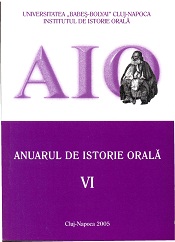VALEA AGRIJULUI ÎN TIMPUL OCUPAŢIEI MAGHIARE (SEPTEMBRIE 1940 – OCTOMBRIE 1944) (I)
THE AGRIJ VALLEY DURING THE HUNGARIAN OCCUPATION (SEPTEMBER 1940-OCTOBER 1944)
Author(s): Cristina BorzanSubject(s): History
Published by: Argonaut
Summary/Abstract: The events that occurred between august and the beginning of September 1940 are renowned and have been comprehensively debated by both the Romanian and the foreign historiography. Facilitated by the development of the international context of that period, they have been the result of the event which took place in Wien on the 30th of August 1940, an incident that has not only had significant consequences for the future unfolding of history, but that has also generated numerous debates and interpretations coming from expert historians in the field of historiography. The study therefore aims to accomplish a reconstitution from the perspective of oral history of the manner in which the Hungarian occupation (September 1940-october 1944) has conducted itself in some areas from the basin of the Agrij Valley. The topic under discussion can be deemed as justified if we bear in mind the painful reality of the Hungarian occupation (Treznea), reported from man to man, region to region, together with the tradition of the common man’s spiritual universe, whose aspirations, dreams and beliefs, as an embodiment of his respect for the departed loved ones, who died for freedom and peace, have always represented essential traits that have ultimately gained an aura of myth or legend. Since then, the tragic tale of the events that took place in some parts of the Agrij Valley during the Hungarian occupation has been passed on from man to man, generation to generation. The starting point of this research, carried out by means of oral investigation, are these genuine but nevertheless not entirely unravelled historical facts, as well as the already born and spreading legends. These testimonies are essential primarily because they convey another kind of history, one that is explained through examples. On the other hand, I consider that the frankness of the witnesses can not be questioned even though in some cases their partiality is obvious, in the sense that they blame only the other part. Nevertheless the majority subscribes to the principle stated by Puşcaş Ioan from Treznea: „I tell you, I ain’t joking’ cause I’m accountable for what I say”. (roughly translated) Another noticeable aspect is the fact that in most cases the typology of the situations portrayed by the people who were interviewed can be traced down in archive documents and in the published bibliographical references on the subject. Regarding the contribution of the study, two things are worth mentioning. To start with, it illustrates for the first time a reconstruction of the general aspects of the hungarian occupation, from various spheres, in some of the parts of the Agrij Valley, portrayed by the accounts of the local folk...
Journal: Anuarul Institutului de Istorie Orală
- Issue Year: 2005
- Issue No: VI
- Page Range: 83-109
- Page Count: 27
- Language: Romanian

